NCERT Solutions for Class 4 Maths Chapter 10 - Elephants, Tigers, and Leopards
| Table of contents |

|
| Page No. 149 |

|
| Page No. 150 |

|
| Page No. 151 |

|
| Page 154 |

|
| Page 156 |

|
| Page 157 |

|
| Page 158 |

|
| Page 159 |

|
| Page 160 |

|
| Page 161 |

|
| Page 162 |

|
| Page 163 |

|
Page No. 149
NIM Game (2 Player Game)
You have played a version of this game in the chapter ‘Vacation with my Nani Maa’ in Grade 3. We will add either 1 or 2 each time to reach the target number 10.
Can you win the game if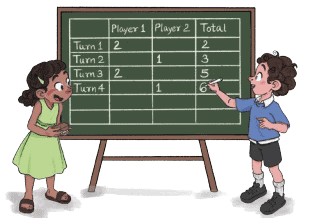 (a) The other player has reached the total of 6 and it is your turn?
(a) The other player has reached the total of 6 and it is your turn?
Ans: Yes, we can win the game. Add 1 bringing the total to 7. On other player’s tun n, the opponent can add either 1 or 2. T-f he/she adds 1, the total becomes 8 and or.i our turn, we can add 2 to reach 10 and win. If he/ she adds 2, the total becomes- 9 and on our turn, we can add 1 to reach 10 and win.
(b) The other player has reached the total of 7 and it is your turn?
Ans: No, we cannot win. We can add either 1 or 2. If we add 1, the total becomes 8 and the other player can a dd 2 to reach 10 and win. If we add 2, the; total becomes 9 and the other player can add 1 to reach 10 and win.
(c) The other player has reached the total of 8 and it is your turn?
Ans: Yes, we can win. Add 2, bringing the total to 10 and we will win. Play the game to reach other target numbers (like 10, 11 or 12) by adding 1 or 2 each time.
Q: Can you find a number in each case when you are sure that you can win?
Ans: Suppose, if other player has reached the total 9 and its our turn, we can add 1 to reach 10 and win. Similarly, we can find some numbers in each case when we are sure that we can win if the target number is 11 or 12. For example, if the target number is 11 and the other player has reached the total 7 and its our turn. Then we can add 1 to reach 8. The other player can either add 1 or 2. If they add 1 the total becomes 9 and in our turn we can add 2 to win.
If the player add 2, the total becomes 10 and in our turn we can add 1 to reach 11 and win. Similarly, if the target number is 12 and the other player has reached the total 8 and its our turn, then we can be sure to win.
Page No. 150
Addition Chart
Q1: Identify some patterns in the table.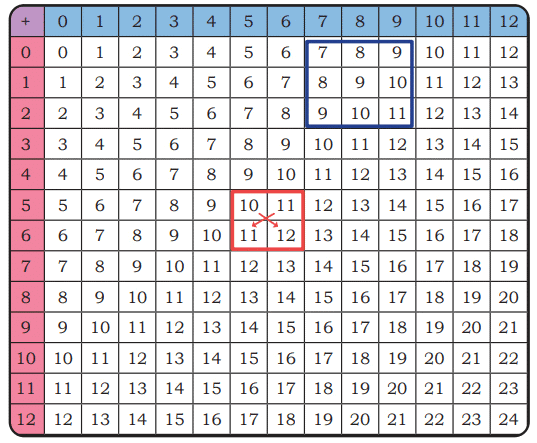
Following are some patterns that can be observed in the table.
- Any number plus 0 remains the same.
- The sum increases by 2 when moving diagonally.
- Each row and column increase by 1 as we move right or down, respectively.
- The table mirrors itself across the main diagonal.
Q2: Observe the cells where the number 9 appears in the table. How many times do you see number 9? What about other numbers?
Ans: There are ten 9’s in the table.
Following are the patterns of appearance of the numbers.
0-one time, 1-two times, 2-three times, …, 12-thirteen times, 13-twelve times, 14- eleven times, 15-ten times, …, 24-one time.
Each number appears one more time than its value till the number 12 and then the appearances of numbers start decreasing symmetrically.
Q3: Are there any rows or columns that contain only even numbers or only odd numbers? Explain your observation.
Ans: Every row and column in the table has both odd and even numbers. This happens because adding two even numbers or two odd numbers gives an even number as resulf while adding one odd and one even number gives an odd number as result.
Q4: Look at the window frame highlighted in red colour in the table.
(a) Find the sum of the two numbers in each row.
Ans: Sum of 10 and 11 = 10 +11 = 21 Sum of 11 and 12 = 11 + 12 = 23
(b) Find the sum of the two numbers in each column. What do you notice?
Ans: Sum of 10 and 11 = 21 (in column)
Sum of 11 and 12 = 23
Again we get numbers 21 and 23 as result.
(c) Now, find the sum of the numbers in each of the two diagonals marked by arrows. What do you notice?
Ans: Sum of 10 and 12 = 22 Sum of 11 and 11 = 22
The sum of the numbers in two diagonals is same.
(d) Now, put the red window frame in other places and find the sums as above. What do you notice?
Ans: If we put the window frame in any two consecutive numbers in row and column, the sum of rows and columns will change but the difference between the sum of any two rows, columns and diagonals will remain the same.
Q5: Identify some patterns and relationships among the numbers in the blue window frame.
Ans: In the blue window frame, numbers in each row and in each column are same and the difference between the sum of numbers of each row and each column is 3.
Page No. 151
Reverse and Add
(a) Take a 2-digit number say, 27. Reverse its digits (72). Add them (99). Repeat for different 2-digit numbers.
- 27 + 72 = 99.
- 45 + 54 = 99.
- 19 + 91 = 110.
Ans: Sums like 99, 110, etc.
(b) What sums can we get when we add a 2-digit number with its reverse?
Ans: Let’s add some 2-digit numbers and their reverse to identify any pattern.
10 + 01 = 11 = 1 × 11
11 + 11 = 22 = 2 × 11
12 + 21 = 33 = 3 × 11
13 + 31 = 44 = 4 × 11
.
.
.
.
.
18 + 81 = 99 = 9 × 11
99 + 99 = 198 = 18 × 11
We can observe that, when we add a 2-digit number with its reverse, we get a number that can be obtained in the times-11 table.
(c) List down all numbers which when added to their reverse give
(i) 55
Ans: 14 + 41 = 55, 32 + 23 = 55, 50 + 05 = 55
Thus, all the numbers that, when added to their reverse give 55 are 14, 23, 32, 41 and 50.
(ii) 88
Ans: 17 + 71 = 88, 26 + 62 = 88, 35 + 53 = 88 44 + 44 = 88, 80 + 08 = 88
Thus, all the numbers that, when added to their reverse give 88 are 17, 26, 35, 44, 53, 62, 71, and 80.
(d) Can we get a 3-digit sum? What is the smallest 3-digit sum that we can get?
Ans: Yes, we can get a 3-digit sum by adding a 2-digit number and its reverse.
The smallest such 3-digit number is 110. As, 19 + 91 = 110.
Fill in the blanks with appropriate numbers.
(a) 
Ans: 
(b) Ans:
Ans:
(c)
Ans:
Page 154
How Many Animals? (Continued)
Q3: Maharashtra has 444 tigers. Madhya Pradesh has 341 more tigers than Maharashtra. Uttarakhand has 116 tigers more than Maharashtra.
(a) How many tigers does Madhya Pradesh have?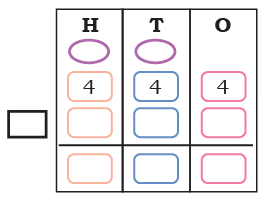 Ans:
Ans: 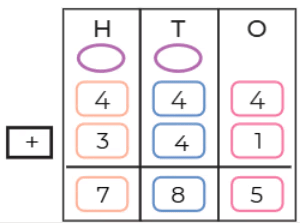
So, Madhya Pradesh has 785 tigers.
(b) How many tigers does Uttarakhand have?
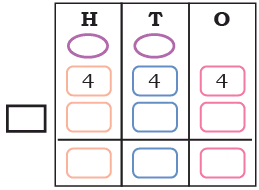 Ans:
Ans:
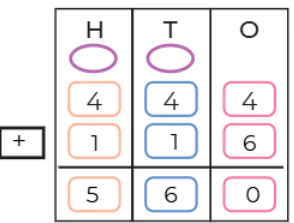
Therefore, there are 560 tigers in Uttarakhand.
(c) How many tigers does Madhya Pradesh and Uttarakhand have?
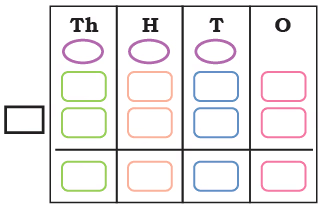 Ans:
Ans:
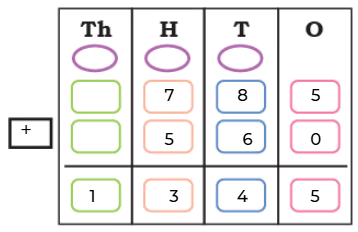
So, there are 1345 tigers in Uttarakhand and Madhya Pradesh.
(d) How many tigers are there in total across the three states?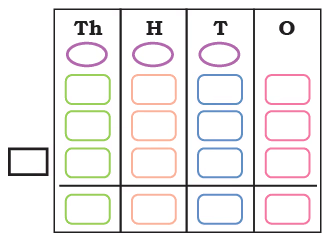 Ans:
Ans: 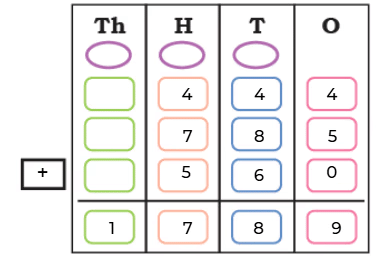
So, there are 1789 tigers across the three states.
Page 156
More or Less?
1. Assam has 5719 elephants. It has 3965 more elephants than Meghalaya. How many elephants are there in Meghalaya?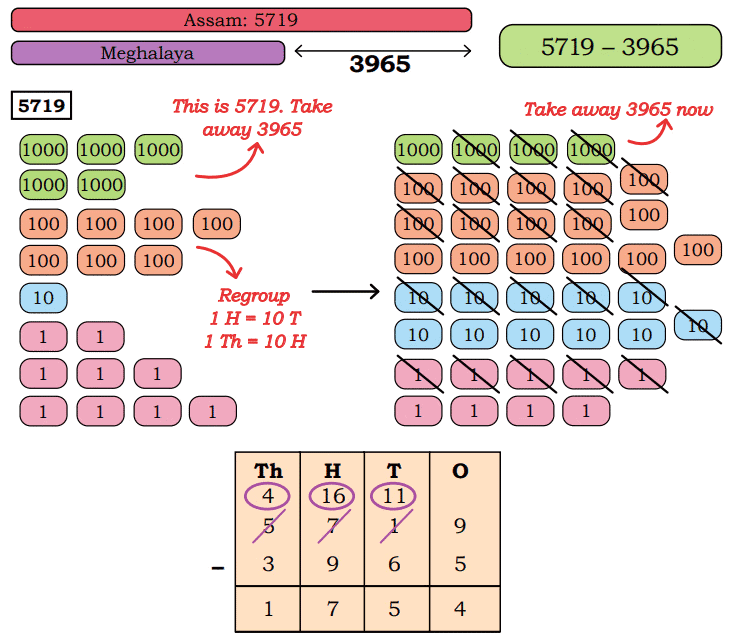 1754 elephants are there in Meghalaya.
1754 elephants are there in Meghalaya.
2. The population of leopards as per the 2022 census was 8820 in the Central India and the Eastern Ghats. It had increased by 749 in comparison to the number of leopards in 2018 in the same region. How many leopards were there in 2018? _________ leopards were there in 2018.
_________ leopards were there in 2018.
Write the number of animals on this map based on the data from the problems in the previous pages.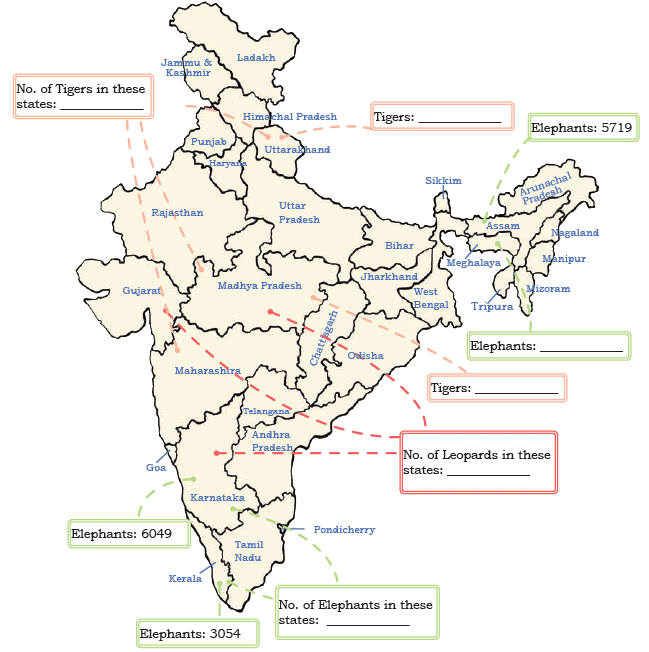
Ans: 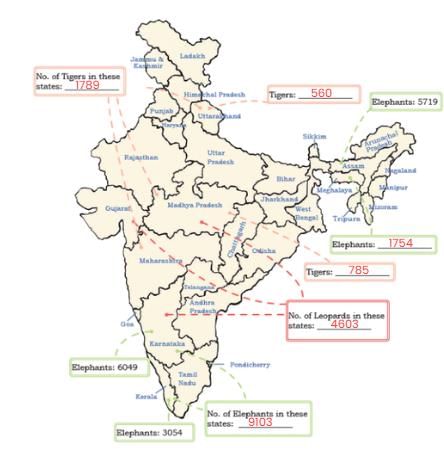
- Elephants: Karnataka (6049), Kerala (3054), Assam (5719), Meghalaya (1754).
- Leopards: Gujarat (1355), Karnataka (1131), Madhya Pradesh (1817).
- Tigers: Maharashtra (444), Madhya Pradesh (785), Uttarakhand (560).
- Ans: Map data as listed.
Page 157
Let Us Do
Q1: The board in the ticket office in the Kaziranga National Park shows the following: (a) How many more visitors came in December than in November?
(a) How many more visitors came in December than in November?
Ans: Number of visitors in December = 8591
Number of visitors in November = 6415
The difference between the number of visitors in these two months = 8591 – 6415 = 2176
Therefore, 2176 more visitors came in December than in November.
(b) The number of visitors in November is 1587 more than October. How many visitors were there in October?
Ans: Number of visitors in November = 6415
Since the number of visitors in November is 1587 more than October.
Therefore, the number of visitors in October = 6415 – 1587 = 4828.
Thus, there were 4828 visitors in October.
Q2: In a juice making factory, women make different types of juices as given below: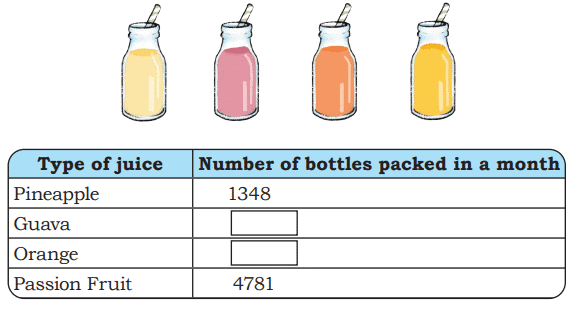 (a) The number of bottles of guava juice is 759 more than the number of bottles of pineapple juice. Find the number of bottles of guava juice.
(a) The number of bottles of guava juice is 759 more than the number of bottles of pineapple juice. Find the number of bottles of guava juice.
Ans: Number of bottles of pineapple juice = 1348.
Number of bottles of guava juice is 759 more than number of bottles of pineapple juice.
Number of bottles of guava juice = 1348 + 759 = 2107
Therefore, the number of bottles of guava juice is the number of bottles of guava juice.
(b) The number of bottles of orange juice is 1257 more than the number of bottles of guava juice and 1417 less than the number of bottles of passion fruit juice. How many bottles of orange juice are made in a month?
Ans: The number of bottles of guava juice = 2107.
Number of bottles of orange juice is 1257 more than the number of bottles of guava juice.
Number of bottles of orange juice = 2107 + 1257 = 3364
Therefore, 3364 bottles of orange juice is packed in a month.
(c) Is the total number of bottles of guava juice and orange juice more or less than the number of bottles of passion fruit juice? How much more or less?
Ans: Total number of bottles of guava juice and orange juice = 2107 + 3364 = 5471
Number of bottles of passion fruit juice = 4781
∵ 5471 -4781 = 690
Thus, the number of bottles of guava juice and orange juice is 690 bottles more than passion fruit juice.
Page 158
Let Us Do (Continued)
Q3: In a small town, the following vehicles were registered in the year 2022. Find the number of vehicles as per the conditions given below.
(a) The number of buses is 253 more than the number of jeeps. How many buses are there in the town?
Ans: Number of jeeps = 6304
Number of buses = 253 more than 6304 = 253 + 6304 = 6557
Therefore, there are 6557 buses in the town.
(b) The number of tractors is 5247 less than the number of buses. How many tractors are in the town?
Ans: Number of buses = 6557
Number of tractors = 5247 less than 6557 = 6557 – 5247 = 1310
Therefore, there are 1310 tractors.
(c) The number of taxis is 1579 more than the number of tractors? How many taxis are there?
Ans: Number of tractors = 1310
Number of taxis = 1579 more than 1310 = 1579 + 1310 = 2889
Therefore, there are 2889 taxis.
(d) Arrange the numbers of each type of vehicle from lowest to highest.
Ans: We have, Jeeps: 6304; Buses: 6557; Tractors: 1310; Taxis: 2889.
The order of these numbers from the lowest to the highest is: 1310, 2889, 6304, 6557.
Answer: Tractors, Taxis, Jeeps, Buses

Q4: Solve
(a) 1459 + 476
Ans: 1459 + 476 = 1935.
(b) 3863 + 4188
Ans: 3863 + 4188 = 8051.
(c) 5017 + 899
Ans: 5017 + 899 = 5916.
(d) 4285 + 2132
Ans: 4285 + 2132 = 6417.
(e) 3158 + 1052
Ans: 3158 + 1052 = 4210.
(f) 7293 − 2819
Ans: 7293 − 2819 = 4474.
(g) 3105 − 1223
Ans: 3105 − 1223 = 1882.
(h) 8006 − 5567
Ans: 8006 − 5567 = 2439.
(i) 5000 − 4124
Ans: 5000 − 4124 = 876.
(j) 9018 − 487
Ans: 9018 − 487 = 8531.
Page 159
Let Us Do (Continued)
Q5: The children in a school in Chittoor are planning to organise a Baal Mela in their school. Raju, Rani and Roja decided to raise some money to make arrangements for the mela. The money is available in notes of 500, 100, 50, 10 and coins of 5, 2 and 1. They decide to put the money in the School Panchayat Bank.
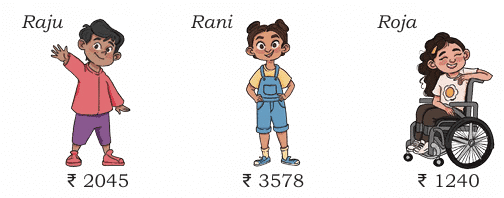 Help each of the children fill the deposit slip given below.
Help each of the children fill the deposit slip given below.
Different combinations of notes can give the same amount. Can you guess a possible combination of notes they might have? Fill in the amounts appropriately.
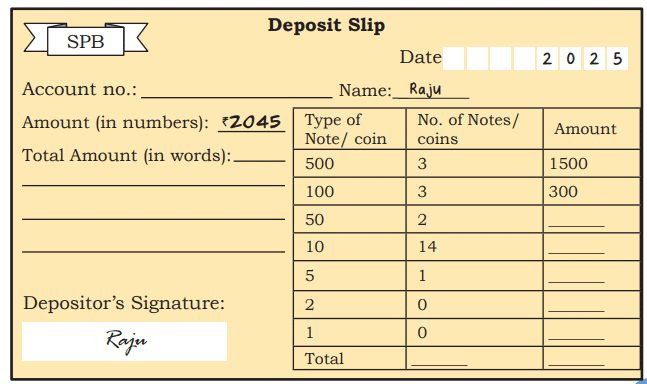
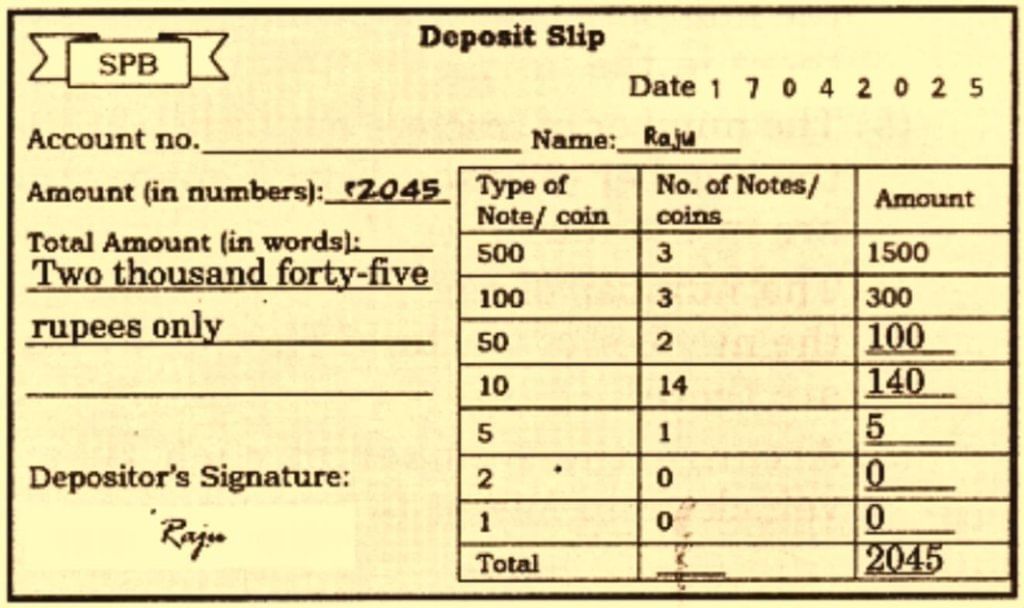
- Total in words: Two thousand forty-five.
Ans: Raju’s slip completed as shown.
Page 160
Let Us Do (Continued)
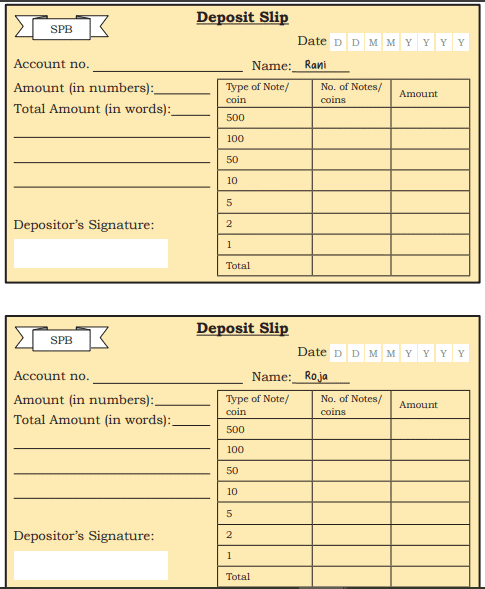
1. Rani
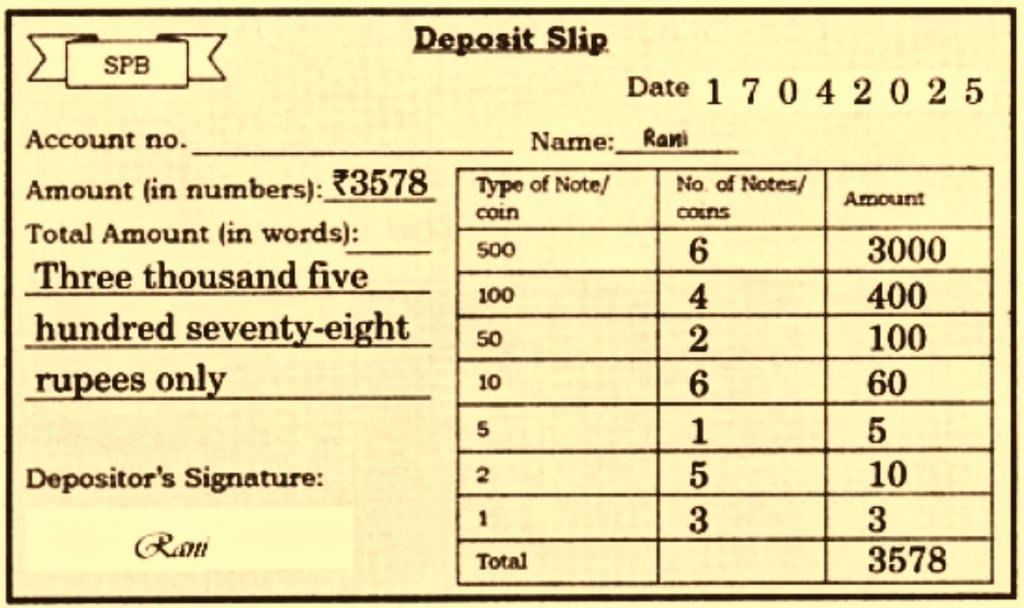
2. Roja
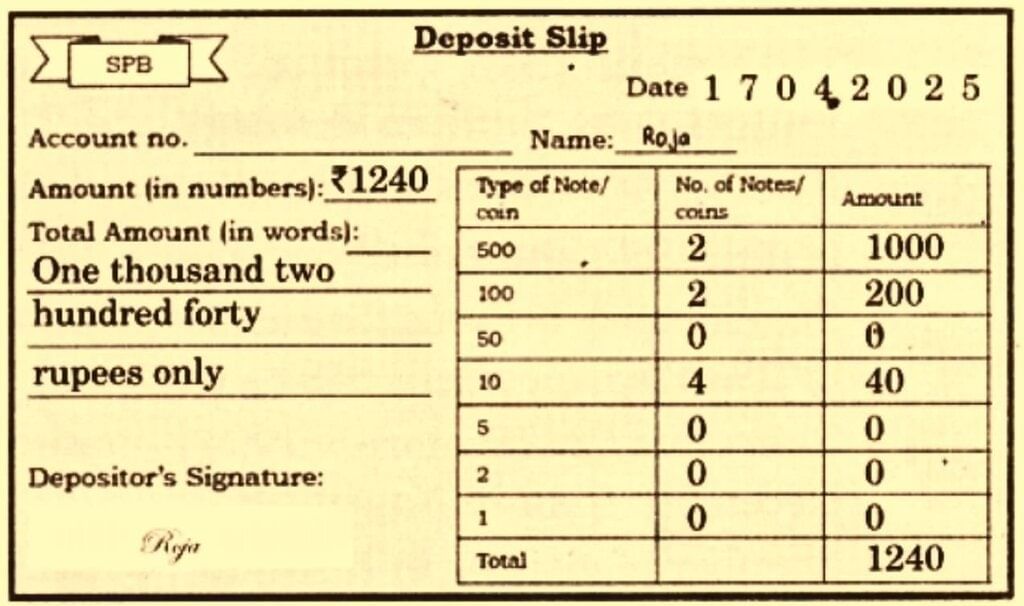
Page 161
Let Us Solve
Q1: Solve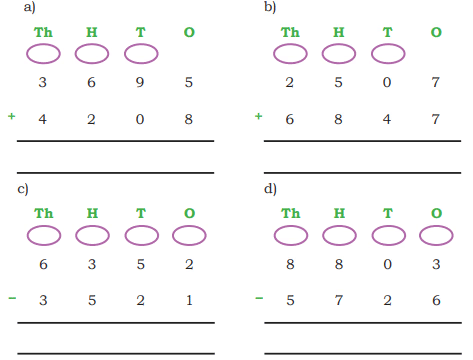 Ans:
Ans: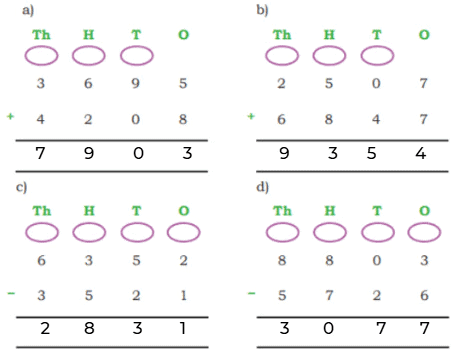
Q2: Arrange the following in columns and solve in your notebook. (a) 3683 − 971
(a) 3683 − 971
Ans: 3683 − 971 = 2712.
(b) 8432 − 46
Ans: 8432 − 46 = 8386.
(c) 4011 − 3666
Ans: 4011 − 3666 = 345.
(d) 5203 − 2745
Ans: 5203 − 2745 = 2458.
(e) 1465 + 632
Ans: 1465 + 632 = 2097.
(f) 3567 + 77
Ans: 3567 + 77 = 3644.
(g) 8263 + 3737
Ans: 8263 + 3737 = 12000.
(h) 5429 + 3287
Ans: 5429 + 3287 = 8716.
Page 162
Let Us Solve
Q1: Find easy ways to solve the following problems. (a) 8787 − 99
(a) 8787 − 99
Ans: 8787 − 100 + 1 = 8688.
(b) 4596 + 104
Ans: 4596 + 100 + 4 = 4700.
(c) 3459 + 21
Ans: 3459 + 20 + 1 = 3480.
(d) 5010 + 95
Ans: 5010 + 100 − 5 = 5105.
(e) 4990 + 310
Ans: 4990 + 300 + 10 = 5300.
(f) 7844 − 15
Ans: 7844 − 20 + 5 = 7829.
(g) 260 + 240
Ans: 260 + 240 = 500.
(h) 1575 − 125
Ans: 1575 − 100 − 25 = 1450.
(i) 3999 + 290
Ans: 3999 + 300 − 10 = 4289.
Q2: Use the signs <, =, > as appropriate to compare the following without actually calculating. Ans:
Ans: 
Q3: Use the given information to find the values.
Ans: 
Page 163
Let Us Solve
Q1: Add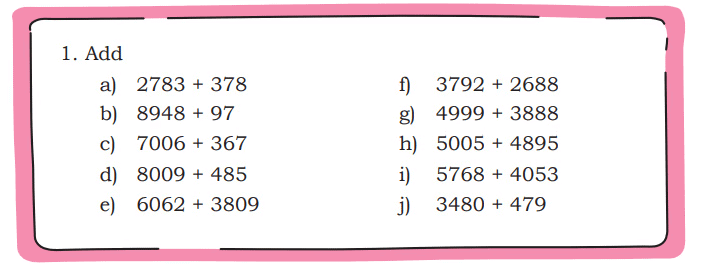 (a) 2783 + 378
(a) 2783 + 378
Ans: 2783 + 378 = 3161.
(b) 8948 + 97
Ans: 8948 + 100 − 3 = 9045.
(c) 7006 + 367
Ans: 7006 + 367 = 7373.
(d) 8009 + 485
Ans: 8009 + 485 = 8494.
(e) 6062 + 3809
Ans: 6062 + 3809 = 9871.
(f) 3792 + 2688
Ans: 3792 + 2688 = 6480.
(g) 4999 + 3888
Ans: 4999 + 3900 − 12 = 8887.
(h) 5005 + 4895
Ans: 5005 + 4895 = 9900.
(i) 5768 + 4053
Ans: 5768 + 4053 = 9821.
(j) 3480 + 479
Ans: 3480 + 479 = 3959.
Q2: Subtract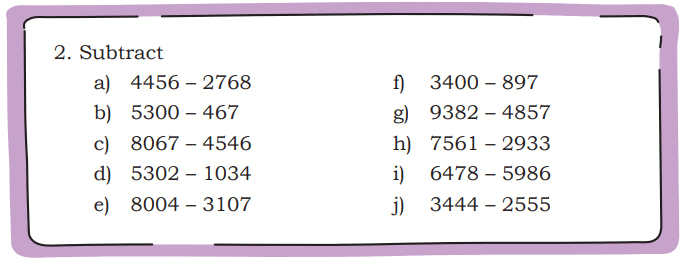 (a) 4456 − 2768
(a) 4456 − 2768
Ans: 4456 − 2768 = 1688.
(b) 5300 − 467
Ans: 5300 − 467 = 4833.
(c) 8067 − 4546
Ans: 8067 − 4546 = 3521.
(d) 5302 − 1034
Ans: 5302 − 1034 = 4268.
(e) 8004 − 3107
Ans: 8004 − 3107 = 4897.
(f) 3400 − 897
Ans: 3400 − 897 = 2503.
(g) 9382 − 4857
Ans: 9382 − 4857 = 4525.
(h) 7561 − 2933
Ans: 7561 − 2933 = 4628.
(i) 6478 − 5986
Ans: 6478 − 5986 = 0492.
(j) 3444 − 2555
Ans: 3444 − 2555 = 0889.
Q3: Fill the squares with the numbers 1-9. The difference between any two neighbouring squares (connected by a line) must be odd.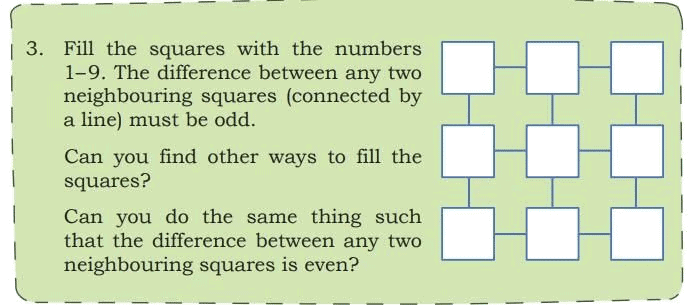 Ans:
Ans: 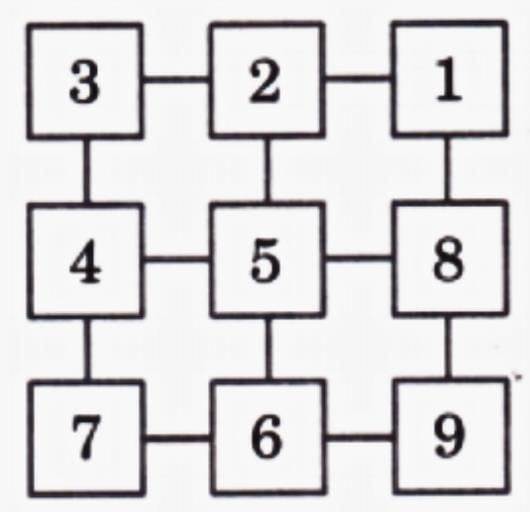
Yes, we can fill the squares in many ways.
No, it is not possible to fill the squares such that the difference between any two neighbouring squares is even. This happens because the difference of either two odd numbers is even or two even numbers is even, means we cannot fill any even number that is connected to an odd number and vice versa, that is not possible in the given connected squares.
|
58 videos|324 docs|14 tests
|
FAQs on NCERT Solutions for Class 4 Maths Chapter 10 - Elephants, Tigers, and Leopards
| 1. What is the objective of the Game to Reach 10? |  |
| 2. How can students practice addition with other target numbers? |  |
| 3. What is included in the Addition Chart? |  |
| 4. How can students determine how many animals are depicted in the activity? |  |
| 5. What activities are included in the "Let Us Do" section? |  |




















